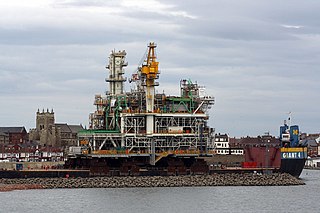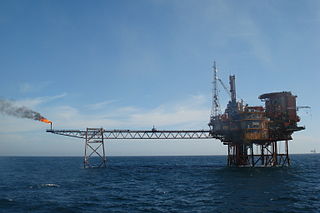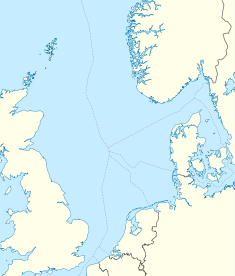The Brae field is a Scottish oil field. The name comes from a Scots language word for hillside. The field was discovered in 1974 by well 16/7-1 drilled by a semi-submersible rig Odin Drill for operator Pan Ocean.

Ekofisk is an oil field in block 2/4 of the Norwegian sector of the North Sea about 320 km (200 mi) southwest of Stavanger. Discovered in 1969 by Phillips Petroleum Company, it remains one of the most important oil fields in the North Sea. This was the first discovery of oil after the drilling of over 200 exploration wells in the North Sea "triggered" by the Groningen gas field discovery. In 1971, Phillips started producing directly to tankers from four subsea wells. Oil production is planned to continue until at least 2050.
Oseberg is an offshore oil field with a gas cap in the North Sea located 140 km (87 mi) northwest of the city of Bergen on the southwestern coast of Norway. The field, which is 25 km long by 7 km wide, was discovered in 1979 and its development is known to be one of the significant milestones in emergence of Norway's independent oil and gas industry. The Oseberg field was named after Oseberg ship, one of Norway's most significant archeological discoveries. The ancient Viking ship from the early 9th century was discovered in a 1904 historical excavation of a burial mound at the Oseberg Farm, south of Oslo.
The Clair oilfield is an offshore oil field in Scottish territorial waters 75 kilometres (47 mi) west of Shetland in water depths of up to 140 metres (460 ft). The field is the largest oilfield on the UK Continental Shelf with an estimated 8 billion barrels of oil-in-place, according to the BP Plc’s website. It extends over an area of some 220 square kilometres (85 sq mi), covering five licence blocks.
Norpipe is a subsea oil and natural gas pipelines system in the North Sea. It supplies oil from the Norwegian Ekofisk and associated fields in the North Sea to the United Kingdom and natural gas to Germany.

Vetco was established in July 2004 and operated through its subsidiaries Vetco Gray and Vetco Aibel AS. Vetco was the result of a consortium consisting of the private equity firms Candover, 3i and JP Morgan Partners taking over ABB's oil and gas division; ABB Offshore Systems. Vetco was made out of companies that have serviced the upstream oil and gas industry since 1903. These companies are suppliers of products, systems and services for onshore and offshore drilling and production, project management, engineering, procurement and construction services, process systems and equipment, maintenance, modification and operations. Vetco was headquartered in London UK, and employed over 10000 people in more than 30 countries worldwide.
Amethyst is a natural gas field in the Southern North Sea, about 30 miles (48 km) east of the Yorkshire coast. Gas lies in a Permian sandstone reservoir around 2,700 metres (8,900 ft) below the seabed. The gasfield is operated by BP.
The Eastern Trough Area Project, commonly known as ETAP, is a network of nine smaller oil and gas fields in the Central North Sea covering an area up to 35 km in diameter. There are a total of nine different fields, six operated by BP and another three operated by Shell, and together, they are a rich mix of geology, chemistry, technology and equity arrangements.
NorSea Com-1, now called Tampnet, is a submarine telecommunications cable system in the North Sea linking the UK and Norway, and connecting five off-shore platforms.
The Magnus oilfield is a large oilfield in the United Kingdom's zone of North Sea. It is located 160 kilometres (99 mi) north-east of the Shetland Islands. The field is located mainly in Block 211/12a. Resources are estimated to total 1.54 billion barrels of oil, of which 869 million barrels are recoverable reserves.
Azeri is an offshore oil field in the Caspian Sea, located 100 km (62 mi) east of Baku, Azerbaijan and is a part of the larger Azeri-Chirag-Guneshli (ACG) project. The Azeri field includes Central Azeri, West Azeri, East Azeri production platforms compression and water injection platform (C&WP). The field was discovered in 1988 and originally it was named after 26 Baku Commissars.
Heimdal is an offshore natural gas field in the North Sea located 212 kilometres (132 mi) northwest of the Stavanger, Norway. Heimdal serves as a connection hub for processing and distribution of natural gas from satellite fields.
Ula is an offshore oil field located in the southern Norwegian section of North Sea along with Gyda, Tambar and Tambar East fields making up the UGT area, usually attributed to DONG Energy's main areas of exploration and production activity.
Tambar is an offshore oil field located in the southern Norwegian section of North Sea along with Ula and Gyda fields making up the UGT area, usually attributed to DONG Energy's main areas of exploration and production activity. The Ula field was discovered in 1983 and came online in 2001. Tambar was discovered in 1983 and became operational in July 2001. It contains confirmed 46.9 million m3 of oil.

The Buzzard Oil Field is an oil field located in the North Sea Blocks 19/10, 19/5a, 20/6 and 20/1s. It was discovered in 2001 by PanCanadian, and developed initially by PanCanadian's successor EnCana and then by Nexen. The oil field was initially operated and owned by Nexen which is now a subsidiary of China's CNOOC.
The Golden Eagle oilfield is an offshore oil field in Scottish territorial waters in water depths of up to 114 metres (374 ft). Located around 70 miles (110 km) north-east of Aberdeen, it occupies licence block 20/1N. The nearby Peregrine field and Solitaire field also form part of the Golden Eagle Area Development.
Alvheim Field is a Norwegian oil and gas field located in the northern part of the North Sea near the border with the British sector, consisting mainly of Boafält, Kneler Field and Kameleon Field. Parts of the Boafält are located in the British sector at block 9/15. The reservoir consists of early-tier sandstone. The depth of the area is 120–130 meters. The production ship is located approximately 12 km west of Heimdal Gassenter, at 59.56684°N 1.99731°E.

The Montrose oil field is a significant crude oil producing field in the UK sector of the central North Sea, 210 km east of Aberdeen. Production of oil started in 1976 and a major upgrade in 2016 extended the field life to beyond 2030.
The Caister Murdoch System (CMS) was a major natural gas collection, processing and transportation system in the UK sector of the southern North Sea. It comprised 11 platforms, 8 subsea wellhead completions and interconnecting pipelines centered about 155 km east of Flamborough Head Yorkshire. It operated from 1993 to 2018.







